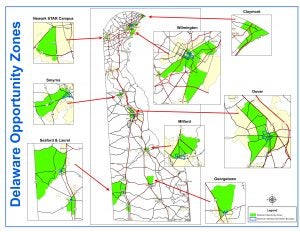Gov. Carney: Improving distressed communities key to Delaware’s success
To accomplish public policy goals, helping Delaware's poorest communities in Wilmington, Claymont, and Seaford is essential.

Delaware Gov. John Carney talks about "opportunity zones" at the University of Delaware's Biden Institute in Newark, Delaware. (Screengrab via Livestream)
To accomplish public policy goals — such as economic development, reducing unemployment and improving education — helping Delaware’s poorest communities in Wilmington, Claymont, and Seaford is essential.
That’s what Gov. John Carney told a group of developers, investors and public policy leaders Wednesday afternoon at an event hosted by the Biden Institute at the University of Delaware.
“If we don’t have investment in these distressed areas, we’re going to have a really hard time doing the other stuff,” Carney said, referring to some of his administration’s goals. “If we have job creation, we’ve got a chance of getting folks that are unemployed or underemployed a job in these areas. We have a chance in providing better education because you’ve got property tax values that are a part of our educational funding mix.”

Twenty-five “opportunity zones,” identified by the U.S. Department of Treasury, span the state from Claymont in New Castle County to Laurel in Sussex County and many locations in between. The federal designation is designed to encourage private investors to develop projects in these locations in exchange for federal tax incentives. The locations include a mix of residential, commercial, and industrial properties.
Carney said the most difficult thing about spurring development in distressed communities is getting private investors to take the risk.
“This is a great opportunity for us, a great tool for our economic development efforts,” Carney said. “Time is of the essence … If you’re interested in helping us use this tool to strengthen our communities and make Delaware a better place, let’s get going and let’s get busy.”
Carney said the opportunity zones include sections of the state’s historically industrial coastal zone. Under the 1971 Coastal Zone Act, industrial activity along the Delaware River was limited to sites already in place in 1971. The act prohibited repurposing abandoned property for anything other than its previous use.
Last year, lawmakers approved legislation allowing for the redevelopment of 14 industrial sites, including abandoned or contaminated properties. Carney said redevelopment is key to cleaning up old industrial locations, and he pointed to the Wilmington Riverfront as an example.
“The riverfront was an environmental mess until we were able to redevelop those sites,” Carney said. “There are other public policy objectives that we’re trying to accomplish with this incredible investment tool.”
Many of the opportunity zone locations have been targeted for downtown redevelopment projects. Investors in those sites are also eligible for state investment rebates, local tax abatements, affordable bridge loans, and other state and local incentives. Since the Downtown Development Districts program launched in 2015, the state has provided about $21 million in rebates that has spurred $371 million of additional public and private investment.
WHYY is your source for fact-based, in-depth journalism and information. As a nonprofit organization, we rely on financial support from readers like you. Please give today.





